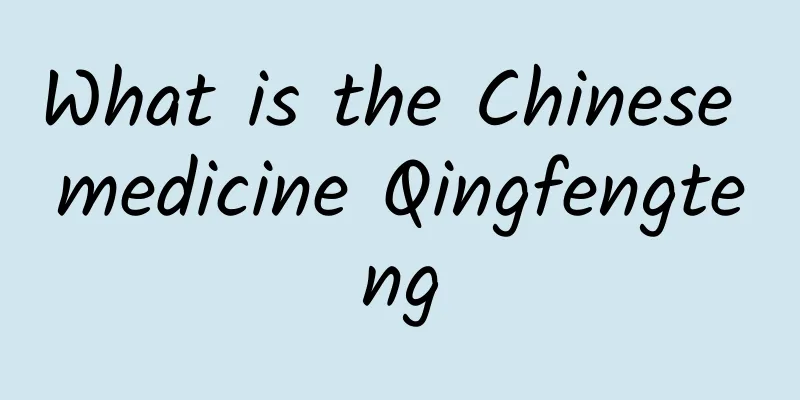What is the Chinese medicine Qingfengteng

|
Health preservation has become one of the most popular keywords in recent years. This is also a phenomenon that arises as people pay more attention to their physical health. The popularity of health preservation has also promoted the development of traditional Chinese medicine, and our country's traditional Chinese medicine theory has begun to regain new vitality. In the eyes of ordinary people, traditional Chinese medicine is a medicine that can both treat the root cause and cure the disease. Although the course of treatment with traditional Chinese medicine is long, the efficacy is very good. So, do you know what the Chinese herbal medicine Qingfengteng is? Ivy is a vine plant. Normally we cut the vines in June and July every year, remove the leaves on the thin stems, and then dry them; or we slowly moisten them with water, cut them into sections, and then dry them in the sun. You can also pick old vines in autumn and winter, cut them into sections, and dry them in the sun. After drying, the green wind vine is long and cylindrical, slightly curved, with thin stems twisted into bundles, 20 to 70 cm long or longer, and 0.5 to 2 cm in diameter. The surface is green-brown to tan, with fine longitudinal lines and lenticels. The nodes are slightly swollen and have branch marks. It is light, hard and brittle, easy to break, with an uneven cross section, grayish yellow or light grayish brown, narrow bark, and radially arranged xylem rays; the pith is small, light yellowish white or yellowish brown, with a slight odor and a bitter taste. Even strips are preferred. Medicinal part: root. Origin: Jiangsu, Zhejiang, Hubei. Harvest: Harvested in late autumn and early winter. Processing: Tie into bunches or cut into long pieces and dry in the sun. Medicinal properties: neutral, medicinal flavor: bitter, pungent, meridians entered: liver, spleen meridians, functions: dispel rheumatism, dredge meridians, and promote urination. Indications: Used for rheumatic pain, joint swelling, numbness and itching. Toxicity: None. Dosage and Administration: For internal use: decoct in water, 9-15g; soak in wine or boil into paste. For external use: decoct in water and wash. Contraindications: People with weak spleen and stomach should take with caution. The Chinese medicine Qingfengteng is indeed very effective. If you prescribe the right medicine for your condition, take it seriously during each course of treatment, and follow the doctor's instructions, your disease will be cured. Just from the Chinese medicine Qingfengteng, we can see that my country's traditional Chinese medicine culture is profound and has a long history. When you get sick in the future, you can take some traditional Chinese medicine under the guidance of a doctor and feel the charm and power of Chinese medicine culture! |
<<: How to eat Houttuynia cordata
>>: Ejiao Blood-Replenishing Granules
Recommend
The efficacy and function of stinky oil fruit
As we all know, stinky fruit is a very common med...
The efficacy and function of hemp leaf hydrangea fruit
Do you know about Hydrangea chinensis? It is a co...
Can the fruit of Paulownia patens be eaten?
The white flowered Paulownia fruit is a fruit tha...
What are the functions and effects of raw Rehmannia?
Shengdihuang itself is a traditional Chinese medi...
Protein factories: Using the power of evolution to defeat the enemy
Evolution has played a vital role in the billions...
How to avoid glaucoma by playing with your phone before going to bed? Take this scientific "home remedy"
The habit of playing with mobile phone before goi...
The efficacy and function of Aconitum kusnezoffii
Everyone is familiar with Aconitum carmichaelii, ...
Seeing the "anonychia" hand reminded me of Voldemort's nose...
What do you think of when you think of people wit...
Mother River Protection Day | Protect the "health" of the Yangtze and Yellow Rivers and look at China's "remedies"
For thousands of years, the surging Yellow River ...
If you touch it, your fingers will be burned! Don't step into the minefield of "mixing and matching" these cleaning agents during the Spring Festival cleaning
Spring Festival is coming Many people started cle...
[Long Man] The well-tempered "special forces": I can defeat the virus!
Editor’s Note: Immune cells are responsible for r...
What are the effects of Cynomorium songaricum
In addition to being made into medicines, many Ch...
The spider disguised itself as an ant, and the real reason was full of blood and tears...
When you think of spiders, what comes to mind? Is...
The efficacy and function of the weasel
Many people are not very clear about the effects ...









